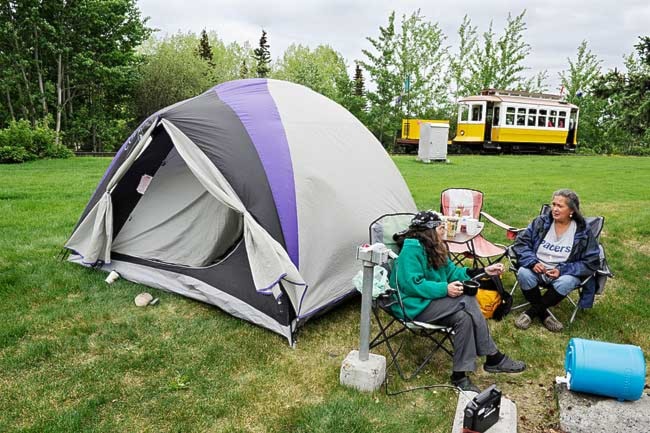The city of Yellowknife has a full-time homelessness co-ordinator.
Dayle Hernblad has been on the job for six years and has overseen the construction of a youth shelter, a 32-unit transition home for men, a day shelter and the continued maintenance of a 44-bed shelter.
A new 22-unit supported living complex for women is in the works.
This gives Yellowknife - population 18,700 - more than 90 shelter beds.
Whitehorse - population 26,400 - has 14.
Whitehorse has never considered employing a homelessness co-ordinator.
“We understand there is a (housing) crisis,” said acting city manager Robert Fendrick.
“But there has been no movement from us. Housing is clearly the mandate of the Yukon government.”
Still, the city sat down with the Yukon Anti-Poverty Coalition this summer to discuss the possibility of creating a tent city downtown for the growing number of homeless in the territory.
“But due to zoning and regulatory processes it would have taken well over a year to set something like this up, and we had no designated site,” said Fendrick.
The city isn’t involved in the Whitehorse Food Bank either, although it makes corporate donations, and Coun. Dave Stockdale volunteers there.
In Yellowknife, the food bank is only one of the city’s food programs.
Hernblad also helped establish a food rescue, where unused food from restaurants and grocery stores is donated to the needy without liability issues.
“So Pizza Hut can give us what isn’t eaten during its lunch buffets, or grocery stores can give us food that is set to expire,” she said.
“We are getting thousands of tonnes of food that used to go straight into the landfill.”
Hernblad’s position is funded federally through the Homelessness Partnering Strategy, which gives designated communities a lump of cash annually to help offset homelessness in their region.
Yellowknife gets roughly $400,000 a year.
Hernblad works with a 40-member committee to determine how best to spend that money.
Comprised of territorial Justice and Health officials, city workers, mental health workers, addictions councillors, federal reps, income services and NGOs, the committee meets monthly to keep the spending on track.
“The committee put together a comprehensive plan and divided the shelter agencies into different populations, like youth, women and men, so they’re not all fighting for the same dollars.”
Working together, the committee oversaw the $6-million construction of a men’s 32-unit transitional housing complex and has a women’s $7-million housing project in the works.
The money comes from the feds, the territory, from fundraising and through corporate sponsorship.
Hernblad’s organization has been hitting up the local mines.
BHP Billiton donated $700,000 for the men’s building, while the territorial housing corporation chipped in another $2 million.
Hernblad’s hunting down similar funding for the women’s 28-unit building.
The Yukon also gets federal funding through the Homelessness Partnering Strategy, thanks to anti-poverty coalition members Ross Findlater and George Green, who jumped at the opportunity and applied to the program in 2000.
“Ross and George were one of the reasons Whitehorse got any money,” said Fetal Alcohol Spectrum Society of Yukon executive director Mike McCann.
McCann, who used to work for Health, sat on the local committee administering the funding, alongside federal reps, city employees and local NGOs, including the anti-poverty coalition.
Over the last decade, the homelessness money has been used to fund youth outreach and shore up Options for Independence, before the territory decided to fund it, and support the Salvation Army and the fetal alcohol society.
“It’s helpful, but it’s always been insufficient,” said Findlater.
The Yukon gets less money than the NWT, even though it doesn’t pay a co-ordinator, like Hernblad.
“The amount we get is not huge - $320,000,” said McCann.
Lately, that money has gone to the Salvation Army shelter and the fetal alcohol society’s outreach program.
The NWT only gets $80,000 more a year, but has managed to build some substantial projects, including its $6-million supported housing complex.
“I think one of our problems is that, right now, there isn’t a plan,” said McCann.
The committee that administers the money hasn’t met for several months, and because none of the money is used to pay a co-ordintator, like Hernblad, the responsibility falls to volunteers.
“At times, I was spending 25 to 30 hours a week working on it,” said Findlater.
Right now, the feds administer Yukon’s funding, but they would like to be more in the background, like they are in the NWT, said McCann.
This means, the Yukon needs to find a community body to run the fund.
“We are hoping maybe the city of Whitehorse would run this whole process,” said McCann.
Just as Hernblad, as Yellowknife’s homelessness co-ordinator, administers the NWT’s money.
This could help set a direction for the funding, said McCann.
“Because there isn’t a plan and we don’t know what our ultimate goals are, or what we’re trying to achieve.”
Look at Calgary, he said.
It set a 10-year-plan to eliminate homelessness, using the same federal funding strategy.
“And they are well on their way to eliminating homelessness,” said McCann.
While in Whitehorse, the situation seems to be deteriorating.
“In Yellowknife, we bring all our local stakeholders together monthly,” said Hernblad.
“It’s nice to have everybody at the table, working toward the same common goal.”
Contact Genesee Keevil at gkeevil@yukon-news.com
